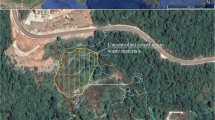Abstract
This paper describes the landslide, terrain, and geology which focused to residential area around the basin occupying Tegucigalpa, the capital of Honduras. The basin has a large residential area in the northern part, and landslides sometimes affect the collapse of houses. Landslides in the studied area (see quadrangle in this paper's figures) were investigated to identify the external and internal factors of the three landslides, El Bambú, El Reparto, and Guillén, and examined the landslide process. In the studied area, the landslides are essentially derived from Slide-type landslide, followed by Flow-type landslide as debris flows, and finally undergo a termination process. Landslides in El Bambú and El Reparto have been stabled due to countermeasures. The Guillén landslide is always active due to the supply of water from residential areas. Internal factors such as topography and geology are generally considered to be landslide characteristics, whereas in the northern part of Tegucigalpa, wastewater from residential areas was found to be causing landslides on the slope located houses as an external factor.
Access this chapter
Tax calculation will be finalised at checkout
Purchases are for personal use only
Similar content being viewed by others
References
Bernhard LT, Sevilla N, Hirota K, Yamagishi H, Tsukamoto S (2018) How to make a database of landslides in Tegucigalpa, Honduras. TXT-tool 4.504–1.1, Landslide Dynamica: ISDR-ICL landslide interactive teaching tools, pp 743–759
Grupo de Mapeo de Deslizamientos de Tierra de Tegucigalpa (2014) Manual para elaboración de mapa de inventarios de Deslizamientos de tierra. Caso de aplicación: ciudad de Tegucigalpa (ISBN 978-99926-701-1), p 80
Harp EL, Castañeda M, Held MD (2002) Landslides triggered by Haricane Mitch in Tegucigalpa, Honduras USGS Open-File Report 02-33, pp 1–11
Harp EL, Held MD, Castañeda M, McKenna JRW (2002) Landslide Hazard Map of Tegucigalpa Honduras. USGS Open-File Report 02-219, p 9
Hirota K, Kamiya S (2014) Re-evaluation of landslide occurred by Hurricane Mitch 1998. Tegucigalpa Honduras. In: Sassa K (ed) Landslide science for a safer geo-environment, vol 3, pp 393–400
Hirota K (2015) Landslides and geology education in Honduras, as activities of Japan International Cooperation Agency senior volunteer. 52(4):36–42
Hirota K (2016) Preliminary Report: Relationship between 9geology and landform in landslides of the Tegucigalpa Basin, Honduras. Second Central American and Caribbean Congress, pp 18–20
JICA (2002) The study on flood control and landslide prevention in Tegucigalpa metropolitan area of the republic of Honduras (official document). Final Report in English version
Moncada R, Yamagishi H (2016) Educational methodologies implemented in Latin America for landslide inventory and analysis. Second Central American and Caribbean Congress, pp 18–20
Rodgers RD, O´Conner EA (1990) Geologic map of the Tegucigalpa quadrangle, Honduras (scale 1:50,000), Instituto Geográfico Nacional
Rogers RD, Mann P, Emmet PA (2007) Tectonic terranes of the Chortis black based on integration of regional aeromagnetic and geologic data. Geological Society of America Special Papers, vol 428, pp 65–88
Varnes DJ (1978) Slope movement types and processes. In: Shuster RL, Krizek RJ (eds) Special Report 176: landslides: analysis and control. Transportation and Road Research Board, National Academy of Science, Washington DC, pp 11–33
Acknowledgements
This investigation was conducted through the JICA project: “Proyecto para el Control y Mitigación de Desastres en Laderas del Distrito Central”. We are grateful to members of JICA project, the JICA Headquarters, the JICA Honduras Office, our counterparts: UNAH (Universidad National Autónoma de Honduras), AMDC (Alcaldía Municipal del Distrito Central), and COPECO (Comisión Permanente de Contingencias).
Author information
Authors and Affiliations
Corresponding author
Editor information
Editors and Affiliations
Rights and permissions
Copyright information
© 2021 Springer Nature Switzerland AG
About this chapter
Cite this chapter
Hirota, K., Rosa, C., Hasegawa, K. (2021). Slope Stability Around the Northern Part of the Tegucigalpa Basin, Honduras: A Case of Landslide Process at Residential Development Areas. In: Arbanas, Ž., Bobrowsky, P.T., Konagai, K., Sassa, K., Takara, K. (eds) Understanding and Reducing Landslide Disaster Risk. WLF 2020. ICL Contribution to Landslide Disaster Risk Reduction. Springer, Cham. https://doi.org/10.1007/978-3-030-60713-5_36
Download citation
DOI: https://doi.org/10.1007/978-3-030-60713-5_36
Published:
Publisher Name: Springer, Cham
Print ISBN: 978-3-030-60712-8
Online ISBN: 978-3-030-60713-5
eBook Packages: Earth and Environmental ScienceEarth and Environmental Science (R0)




